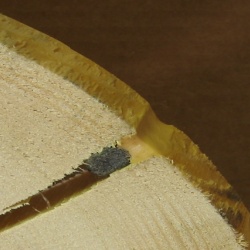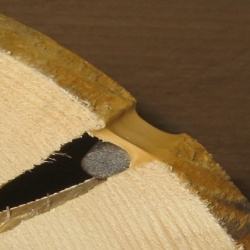Do checks need to be sealed? Upward facing checks can collect water increasing the interior moisture content of the log. If they continue to collect water and the wood remains damp, they can eventually result in internal wood decay as well as provide nesting sites for carpenter ants and other insects. It is not necessary to seal checks on the bottom half of round logs since they do not collect water but for a uniform appearance you may want to seal them too. It is not usually necessary to seal checks or fissures that are less than ¼” wide since can't accumulate that much water.
If your home is new and the logs or siding are green, it may be best to wait a year or so before addressing the checks. This allows the wood to reach an equilibrium with its environment and by then most of the larger checks will have opened. On seasoned wood or an older home that's in the process of being refinished you can seal the checks either before or after applying a stain.
Checks and splits in logs present a different set of dynamics than those typically addressed by a caulk. They open and close as the log's moisture content varies throughout the year. The opening width of a check may change as much as 50% from summer to winter. Most sealants are designed to cope with a different set of conditions and are ill suited for sealing checks. Check Mate 2 is specifically formulated to meet the particular requirements for sealing checks that appear in logs and log siding.
 |
 |
| Under Compression (closed) | Stretches Under Expansion (open) |
